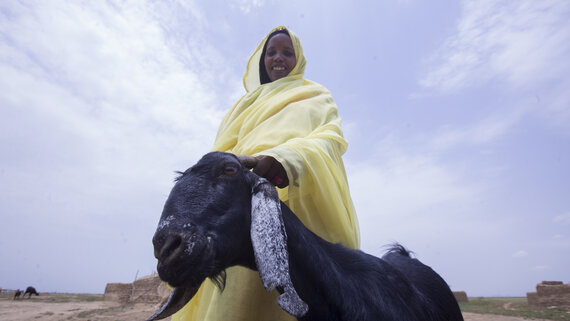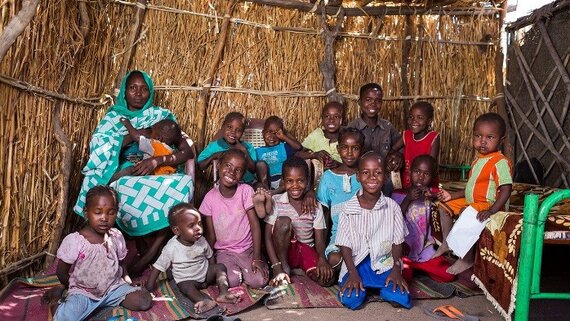Analysis of the context, crisis and needs
During the second year of transition, the Government of Sudan continued its efforts to establish peace in the country, reforming the economy, working towards macroeconomic stability, and supporting the needs of the most vulnerable people. On 9 June, the government lifted fuel subsidies and completely liberalised fuel prices. This led to a fifty-fold increase in the price of petrol (the subsidized price of petrol was 6.17 SDG and the price after the lifting of the subsidies was 320 SDG). Following these reforms, the exchange rate and the inflation rate were expected to stabilize starting from 2022 and remain moderate for the coming years. On 28 June, the IMF Executive Board announced that Sudan had reached the decision point for the Highly Indebted Poor Countries initiative. Following commitments made by Member States in Paris on 29 June, the IMF and the World Bank approved initial debt relief for Sudan, reducing the country’s debt from US$56 billion to $28 billion. However, it will take time before the country sees the positive impact of these changes including that of economic reforms.
While the military coup d’état of 25 October 2021 had a limited immediate consequence in humanitarian operations, the pause of development assistance could influence basic social services and programmes supporting people’s ability to bear the impact of economic reforms.

Kassala, Sudan
An early warning system predicted a drought in Kassala, Sudan. Animal health treatments and feed mitigate the impacts of the drought and enable farmers to protect their livelihoods and food security. Sudan has long been known as one of Africa’s most arid countries, but rainfall in recent years has become even more erratic. Extreme events, such as drought, are becoming more common. Seventy per cent of rural people in Sudan rely on rain-fed agriculture and livestock-rearing, but the unpredictable and intense conditions, such as those in Kassala, are stretching their coping capacities to the limit. The cumulative effects of this "new normal" are taking a toll; one drought can follow another, each time stripping away hard-earned but limited resources.
FAO/Ahmedalidreesy AbdilContinuing economic crisis, including high inflation, resulted in elevated levels of food insecurity, while hundreds of thousands of displaced people in Darfur and other parts of the country remain in protracted displacement needing specific assistance including protection. Over the past year, parts of the country – including in Darfur and South Kordofan – witnessed increased insecurity and localized violence. Since the beginning of the year, over 365,000 people were displaced, many of whom were already displaced as a result of the crisis in Darfur in 2003-2004, and in South Kordofan in 2011 and onwards. Flooding and concurrent disease outbreaks are straining the limited ability of state institutions to provide basic services. Despite these challenges, the country hosts about 1.2 million refugees and asylum seekers, making Sudan one of the top 10 refugee-hosting countries.
In 2021, heavy rains and floods affected about 314,000 people. An increase in waterborne and vector borne diseases, including watery diarrhoea, typhoid, malaria and dengue fever, is foreseen in the coming months. During the first nine months of 2021, about 1.6 million cases of malaria were reported across Sudan, while about 2.2 million cases were recorded in 2020. Since the end of August, the national health authorities have reported three concurrent disease outbreaks following the rainy season. Specifically, multiple cases of Hepatitis E, dengue fever and measles were registered in different country states, further exacerbating an already precarious health system.
Projected situation in 2022 and beyond
About 14.3 million people –almost one in every three people–- across the country are projected to need some sort of humanitarian assistance in 2022. Close to 64 per cent of those 9.1 million people in need will require emergency assistance for life-threatening needs related to critical physical and mental well-being. This is quarter increase compared to the previous year, highlighting the enormous hardship that many people face. Meanwhile, 14 million people –- or 98 per cent of those in need – require life-sustaining support to meet minimum living standards. These figures indicate an increase in needs and a worsening of the severity of needs. The highest needs include water and sanitation, food security and health. Approximately 8 million people in need are women and girls. Particularly vulnerable groups include 2.9 million displaced people and 1.2 million refugees. Khartoum, North Darfur and South Darfur states account for most of the increase in the number of people in need. Meanwhile, it is estimated that it will take time to find and implement durable solutions for internally displaced persons (IDPs), both protracted IDPs and newly displaced people, as well as the 1.1 million refugees.

Kalma, Sudan
This displaced mother of five lives in Kalma camp, South Darfur. Her two youngest children suffer from malnutrition and are benefitting from nutrition activities. Through WFP’s cash and food vouchers, the family also receives monthly food assistance that includes sorghum, oil and salt. She explains: “My family and I fled our home, leaving behind everything we owned, to seek safety away from the terror brought by war. We came to this camp we now call home with nothing but the clothes we were wearing. My husband was very ill and was not doing well. A year from our drastic life transformation, he passed away. He gave me these three beautiful kids before his passing, and I am very grateful. But life as a single woman is tough, so I re-married here in the camp five years ago and gave birth to two more children. Their father is away for work and does not come back often. He tries his best to support us financially, but it is not enough. So, I work as a Tea Lady in the market, while my eldest son helps by picking mangoes and selling them in the market. We don’t make much, but we manage to get by."
WFP/Alaa KeirThe humanitarian situation in Sudan is compounded by deep-rooted poverty and an economic crisis. The country faces several overlapping challenges, including internal population displacement triggered by conflict, and climatic and socio-cultural conditions leading to high levels of food insecurity and malnutrition. However, the economy is the main driver of people in need. For the Humanitarian Needs Overview (HNO) 2022, the drivers of need have been broken down into five main categories: the economy, localized conflict and protracted displacement, natural hazards, disease outbreaks and food insecurity.
According to the International Monetary Fund, the economy in Sudan has been in recession since 2018, with a projected economic growth for 2021 of 0.9 per cent. The near-term economic growth, the key to tackling the economic crisis, will continue to be subdued owing to low consumption and investment owing to factors such as high inflation and unemployment. In 2022, the economic growth is expected to be 3.5 per cent. However, these growth rates are not sufficient in the immediate term to drastically reduce food insecurity levels and other vulnerabilities induced by the economic crisis. It is also estimated that more than 350,000 people are likely to be affected by heavy rains and flooding across Sudan in 2022, with many needing shelter, water, sanitation and other support.
Response priorities in 2022
Humanitarian organizations scaled up assistance in 2021 despite operational challenges posed by COVID-19, the economic crisis and the October 2021 coup d’état. Improvements in humanitarian access under the transitional civilian government have continued, and sustained humanitarian access has been witnessed in areas under non–State armed groups' control.
In 2021, operations continued to grow in response to an increment of humanitarian needs driven by unaddressed root causes of the crisis and underlying factors. By June 2021, humanitarians reached more than 7 million people with some form of assistance. In 2022, US$1.9 billion is required to support the humanitarian response. The funding requirements are backed up by detailed activity-costing with targets at the locality (second administrative level).
Sudan HRP
In 2022, the Humanitarian Response Plan (HRP) will ensure an inclusive and dignified humanitarian response to the most vulnerable people within Sudan. The response will prioritize life-saving multisectoral assistance in areas with the highest convergence of severity of needs, including response readiness for recurring flooding, conflict and disease outbreaks. Partners will scale up food assistance, disease prevention and response, and emergency response to those newly displaced by conflict or flooding. The response will also prioritize life-sustaining services, such as essential health services, surveillance of and response to waterborne and vector borne diseases, education, livelihood opportunities, water and sanitation, supplemental nutrition and school feeding. Finally, the HRP will prioritize the mitigation of and response to protection needs. Where possible, the humanitarian aid delivery will also aim to build community capacity, sustain durable solutions and promote social peace.
Achievements and innovations
The 2022 HNO and HRP were developed using evidence-based primary and secondary data sources, such as a vulnerability assessment focused on refugees (BANVA), Displacement Tracking and Monitoring, in-depth secondary data review using the Data Entry and Exploration Platform (DEEP), the IPC and a Multi-Sectoral Needs Assessment (MSNA). The 2021 MSNA survey for Sudan overcame most of the challenges faced during the previous year, significantly reducing the phone-based data collection and increasing the geographical coverage. A total of 19,000 households were reached during the survey, a third more than in 2020, with 76 per cent of the survey (14,405 households) using a face-to-face approach despite COVID-19-related challenges.
Additionally, DEEP was introduced in Sudan for the first time, producing a first-level analysis of secondary data available, including key findings aligned with the Joint Intersectoral Analysis Framework. DEEP analysed 162 reports from 2021, cataloguing 7,212 unique data points. The secondary analysis document comprises 10 sections covering everything from the context and humanitarian access to the impact of COVID-19 and priority of needs.
Further reading
Source: OCHA
Source: Humanitarian Insight
Source: Financial Tracking Service



